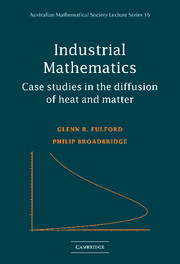7 - Conclusions
Published online by Cambridge University Press: 14 January 2010
Summary
In this final chapter we review the case studies examined in this book. We also explore (very briefly) some other areas of industry in which mathematics has been extensively used and mention some other mathematical techniques which commonly find application in industry.
Introduction
In the previous chapters we have explored several case studies from industry. All of these case studies have involved problems which use some variant of the diffusion equation. The case studies were deliberately chosen to use similar mathematics and physical backgrounds to make it easier for the reader and to allow the reader to see the links between the various case studies through mathematics.
In Chapter 2 we considered the problem of continuous casting. This problem introduced the mathematics of moving boundary problems and of similarity solutions using the Boltzmann similarity solution. The problem illustrated how a simplified model involving one dimensional heat flow yielded an exact solution in terms of error functions. Using this exact solution we were able to estimate the size of the puddle of molten steel, and showed that it was of the order of the size of the rotating drum, which meant that the process was not feasible.
Next, in Chapter 3, the case study was from the area of water filtration involving a process known as reverse osmosis. This was a diffusion problem with a non-constant advection coefficient. Here we continued with the idea of a similarity solution, and developed a technique (the method of stretching transformations) as a means for constructing similarity transformations which reduce the dimensionality of a partial differential equation.
- Type
- Chapter
- Information
- Industrial MathematicsCase Studies in the Diffusion of Heat and Matter, pp. 189 - 194Publisher: Cambridge University PressPrint publication year: 2001



